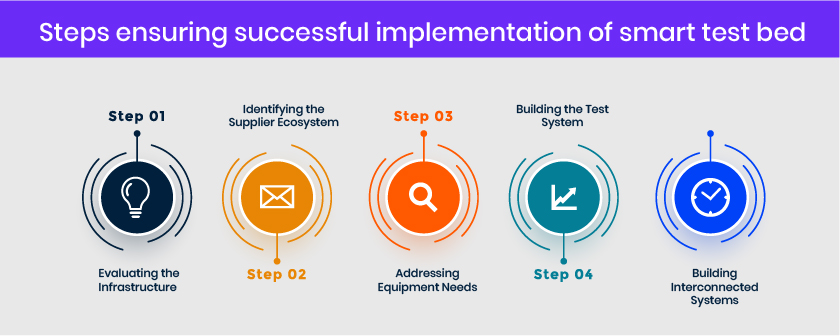Ensuring the Successful Implementation of a Smart Test Bed
As the world around us becomes embroiled in VUCA, organizations and industries globally look for ways to improve resilience and responsiveness in their business. The rise of technologies such as AI and the revolutionizing Industry 4.0 has been a response to changing market demands and the increasing need to drive cost effectiveness while influencing productivity and profitability.
Along those lines, increased automation, the use of sensors, and the focus on data to drive decisions are remarkably transforming industries. As we move deep into the age of Industry 4.0, it becomes imperative to drive the holistic optimization of testing operations. This is especially important as the scope of the scenarios to be tested and the pursuant data to be processed has increased exponentially.
In our previous blog (Benefits of a Smart Test Bed), we discussed the need and benefits of smart test beds. In this blog, we aim to highlight the key considerations for implementing a smart test bed.

Implementation of Smart Test Beds
Traditional testing methodologies demand the test facility manager to do an inordinate amount of heavy lifting. Managing the entire infrastructure’s maintenance needs and equipment falls under their purview. This spans from optimizing the test lab with the right test beds and connecting with the right suppliers to sourcing the right testing equipment and addressing the utility needs of the equipment and infrastructure.
It’s noteworthy that automotive test beds are physical units and contain multiple components that must be tied together seamlessly. There are special considerations that some components demand. Since several components are sourced from suppliers, test facility managers must ensure that the component needs are clearly identified and documented for accurate calibration.
With so many moving parts and multiple stakeholders, there’s much to consider while implementing a smart test bed. Here is what goes into it.
Evaluating the Infrastructure
Test facility managers have to evaluate the capabilities of the existing testing infrastructure in comparison to the expected testing outcomes to make the right decisions.
In most cases, facilities managers have a test bed or two and the basic test lab in place. The rest of the test beds and equipment are sourced from suppliers. The facility manager has to account for the utility needs of the test beds and the equipment and ensure that the existing infrastructure provides the same.
The test infrastructure must be set up such that the entire testing process, right from receiving the test request to conducting the test and supplying back the test data becomes an organically connected and seamless process.
Identifying the Supplier Ecosystem
Test systems are expensive items. Hence, facility managers must carefully assess the supplier ecosystem and identify the best suppliers with systems that can fulfill the testing needs while remaining cost-efficient. They also need to evaluate these test systems’ maintenance and support needs and ensure that the suppliers provide the same.
Essentially, the suppliers and the test facility manager must work together to drive good testing outcomes and partner for success. As such, having granular details into the maintenance needs of these systems becomes crucial to ensure proactive, predictive, and preventive maintenance.
Addressing Equipment Needs
Most of the equipment used to build smart test ecosystems is standalone. The facility manager ascertains that all the needs of equipment, calibration considerations, maintenance, and utility requirements are correctly and methodically collected. Since some equipment comes from suppliers, the facility manager must collect the same in an organized and detailed format.
When addressing equipment needs, the facility manager has to ensure that the equipment needs are not evaluated in isolation. Since these are critical pieces of equipment that need to provide clear and exact data, it becomes essential to take a holistic look at equipment needs in relation to the whole ecosystem. This helps in calibrating equipment more accurately and ensures that data quality is on par and reliable.
When purchasing the equipment, test facility managers must ensure that they can install and integrate these with the automation systems at work. Thus, evaluating equipment compatibility and assessing the flexibility of the automation system becomes necessary.
Building the Test System
A smart test system consists of many components. These are:
- The electromechanical component: This component is all about the engineering competencies of the system at work.
- The automation system: This system sits on top of the test equipment and ensures that the equipment runs in an automated mode with low or no human intervention. It is crucial to ensure that the automation system is well designed, supports the test process, and reasonably integrates all the equipment and sub-equipment to run automated tests.
- The sensors ecosystem: Creating a smart ecosystem is essential to implementing a smart test bed. However, traditional ecosystems are lacking in this smartness. Implementing a smart test bed does not demand a complete overhaul. Instead, facility managers can look at building a robust sensor ecosystem to build in smartness and connectivity. Just like adding an automation layer to a traditional test bed elevates its smartness, adding sensors to areas such as equipment and utilities helps create a connected environment.
- The simulation automation and control components: This functionality helps in making tests more comprehensive and reliable. Adding a simulation component to the test bed allows organizations to test real-world data and simulate it in a lab. Data, for example, can be collected from the road to create a simulation environment. This data can then be executed in the same test bed, and the results can be assessed for effectiveness. This increases the efficiency of tests, reduces costs, and ensures better product quality as tests can be more comprehensive.
Building Interconnected Systems
Seamless interconnectedness is crucial to the success of the smart test data. Since data accuracy is vital to testing success, ensuring that all the moving parts of the smart test ecosystem are aligned, connected, and calibrated with absolute precision is imperative.
The problem with traditional systems is that data resides in silos. Leveraging siloed data becomes effort-intensive and often error-prone. Therefore, during the implementation of the smart test bed, the facility manager must ensure that the entire testing system is integrated. This confirms that while there could be multiple test labs, they can all be run as one unit and do not need multiple people running and managing them.
Building interconnectedness between the test bed, automation systems, host systems for the test equipment, simulation automation, and control components ensures that the data moves seamlessly. It also becomes easier to share and collaborate as this system becomes the single source of truth.
Test facility managers, however, must ensure that if they are employing third-party automation, this system can connect directly with the underlying system and can route the data to the different host levels easily. They also need to ascertain well-defined separations between the different host systems so that the tests can be routed to the right test beds.
Conclusion
Creating a smart testing infrastructure that delivers a collaborative development & validation framework and complex simulation models becomes crucial to driving testing velocity and accuracy.
Greater testing accuracy, enhanced responsiveness, better cost optimization, higher product quality, and improved profitability emerge as organic outcomes of this shift.
Keep tabs on this space as we dive deeper into the elements that make smart testing click.



